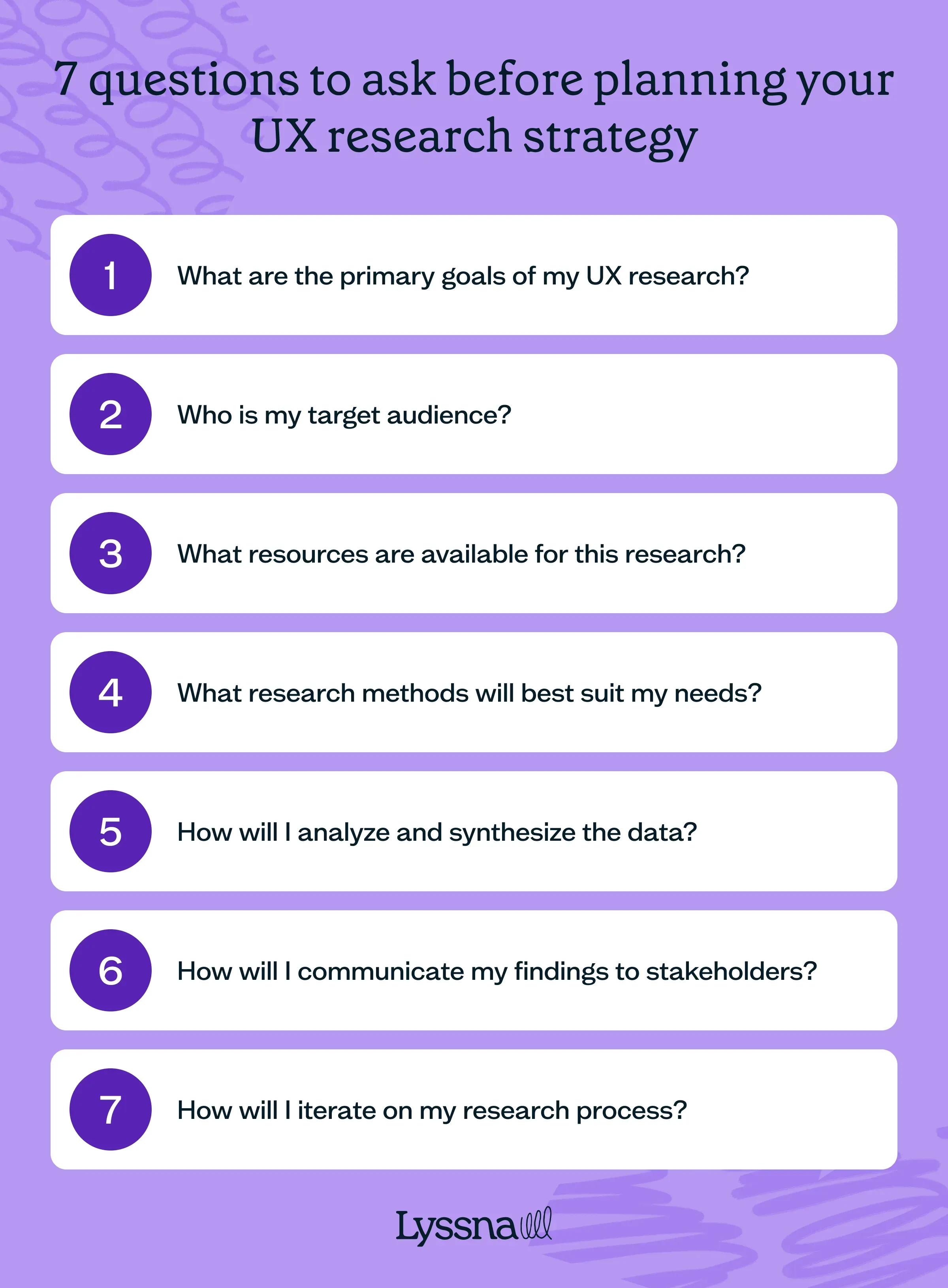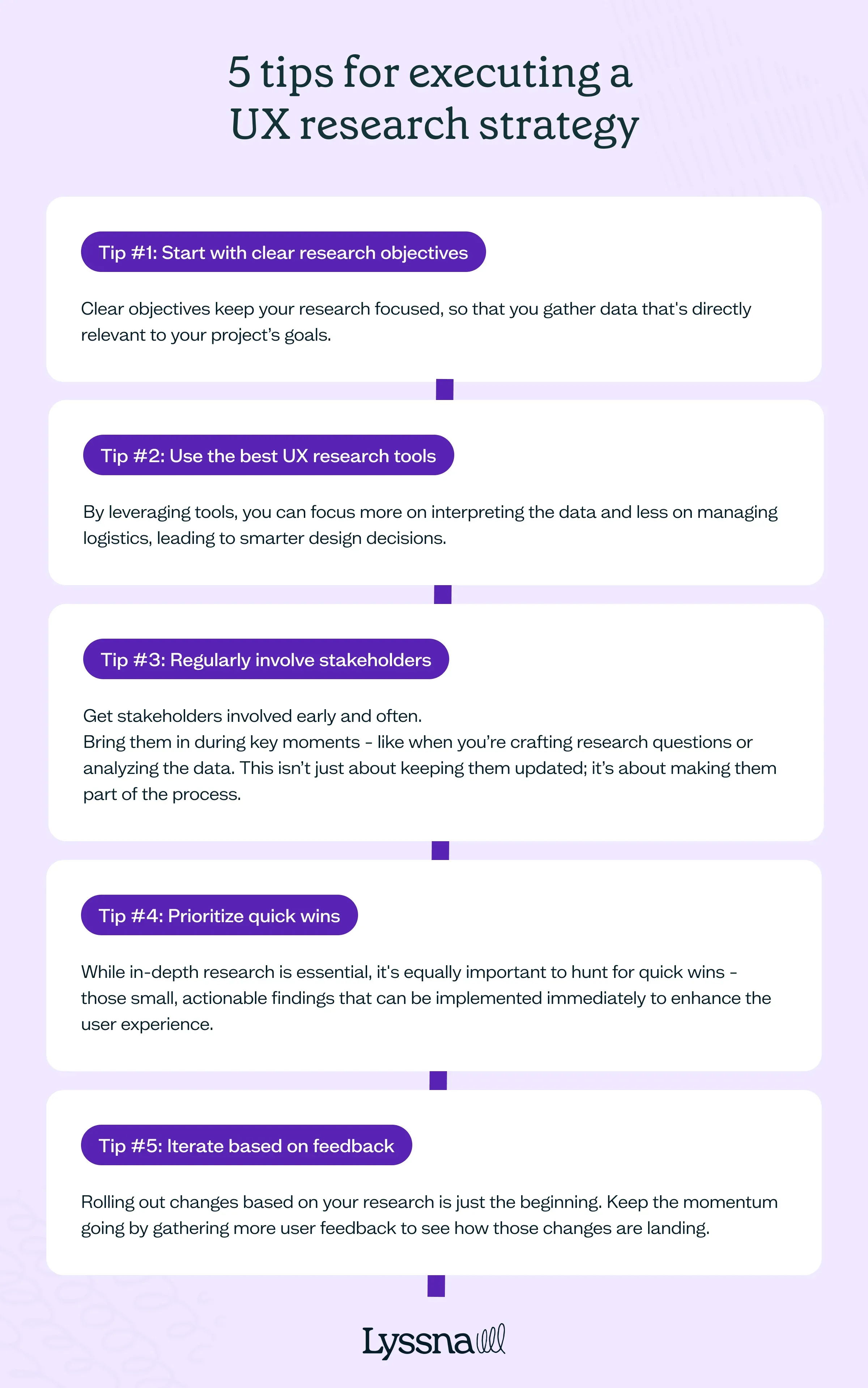UX research strategy
"Pay attention to what users do, not what they say." – Usability pioneer Jakob Nielsen A solid UX research strategy is all about connecting the dots between what users say, what they do, and what they really need – even when they don’t realize it themselves. It’s your secret weapon for catching issues early, saving time and money, and ultimately creating products that aren’t just functional but intuitive and enjoyable to use. This chapter dives into the benefits of a well-crafted UX research strategy and offers actionable steps to help you build your own. The goal? To craft experiences that users will love – and keep coming back to.
UX research guide
What is a UX research strategy?
A UX research strategy is a comprehensive plan that outlines how you’ll conduct user research to guide design decisions and improve the user experience. It acts as a roadmap, leading you through the processes of gathering, analyzing, and synthesizing user insights to create a product that aligns with their needs.
At its core, a UX research strategy aims to answer two fundamental questions:
What are the user’s needs and behaviors?
How can this information shape the design process?
As Steve Jobs famously said, “You’ve got to start with the customer experience and work backward to the technology.” This philosophy underpins every successful UX research strategy, ensuring that products are designed with a thorough understanding of user needs, behaviors, and pain points.
By systematically addressing these questions, you can sidestep common pitfalls – like misaligned product features, ignored user pain points, or wasted resources on irrelevant research – and remain focused on creating products that resonate with users.
The benefits of a UX research strategy
A strong UX research strategy ensures your design decisions are informed by real user data, reducing guesswork and increasing the likelihood of delivering a product that meets user needs.

1. Clarity and focus
A UX research strategy helps pinpoint the most effective research methods – like user interviews, surveys, or usability testing – based on your project’s specific goals. This targeted approach saves time and resources, ensuring you collect relevant feedback.
2. Improved collaboration between teams
Involving designers, product managers, and other stakeholders early in the research process fosters a shared understanding of user needs and project goals. This collaborative environment improves communication and helps to make sure that everyone is aligned, working toward the same goals. The result? More cohesive and user-centered designs.
3. Increased adaptability
These days, user preferences and market conditions can change in the blink of an eye. A UX research strategy provides a continuous feedback loop, allowing you to adapt your product in real time based on ongoing user insights. This adaptability helps to keep your product relevant and responsive to evolving user needs.
4. Helps secure stakeholder buy-in
Clear, research-based findings make it easier to get buy-in from key stakeholders, helping you justify design decisions and allocate resources more effectively. This support is essential for successfully integrating UX research insights into the final product.
By anchoring your design in user insights, you’re not just building functional products – you’re delivering solutions that genuinely connect with and satisfy your users.
UX research strategy vs UX strategy: Is there a difference?
It's easy to mix up "UX research strategy" and "UX strategy" – but they’re not the same. Although they’re closely related, each plays a distinct role in the product development process, and knowing the difference is key to leveraging them effectively.
UX research strategy
A UX research strategy focuses on the methods and processes for gathering, analyzing, and synthesizing user data. It’s your plan for how you’ll conduct user research, which tools and techniques you’ll use, and how you’ll turn those findings into actionable design decisions. The core aim is to build a product with a deep understanding of user needs, behaviors, and pain points.
In essence, it’s a specialized subset of the broader UX strategy, focused exclusively on the research phase.
UX strategy
A UX strategy, on the other hand, takes a bird’s-eye view of the entire user experience process. It’s a comprehensive plan that steers the overall direction of a product's UX, from initial research and design through to development and evaluation. It’s about defining the product vision, setting UX goals, and ensuring that every part of the product aligns with these goals.
So, while a UX research strategy is about gathering user insights, a UX strategy encompasses the full journey of designing the user experience. Both are crucial, but each serves its own unique purpose in crafting a successful, user-centered product.
7 questions to ask before planning your UX research strategy
Before diving into your UX research strategy, take a moment to step back and ask yourself some key questions. These will help sharpen your focus, identify potential roadblocks, and make sure your strategy aligns not just with user needs but also with your business goals.

Question #1: What are the primary goals of my UX research?
Start by defining the main objectives of your research. Are you aiming to enhance an existing product, validate a new concept, or uncover unmet user needs? Clear goals will guide your choice of research methods and make sure that your findings have a real impact on the product’s success.
Question #2: Who is my target audience?
Identifying your users is essential. Look at demographic details like age, location, and occupation, alongside psychographic attributes such as values, interests, and behaviors. Knowing your audience helps you tailor your research methods, making sure your findings are both relevant and actionable.
Question #3: What resources are available for this research?
Evaluate the resources at your disposal – time, budget, and personnel. Limited resources may require you to prioritize certain research activities or seek more efficient ways to gather data. Recognizing these constraints early helps you plan a strategy that's both realistic and effective, allowing you to make the most of what you have without overextending.
Question #4: What research methods will best suit my needs?
Different research methods yield different data. User interviews can offer deep insights using various qualitative methods of research, while surveys provide broader quantitative data. If your goals point toward quantitative analysis, exploring the various methods of quantitative research can help you choose the right approach. The right choice depends on your research goals, the complexity of the issues you’re exploring, and the resources you have available. Matching methods to your needs ensures you gather the most valuable information.
Question #5: How will I analyze and synthesize the data?
Collecting data is just the beginning. The true value lies in how you analyze and synthesize this information to generate actionable recommendations. Consider your approach – will you categorize and interpret findings manually, or rely on software tools for analysis?
Planning this step carefully ensures that your research doesn’t just churn out data, but drives meaningful, impactful results to shape your next moves.
Question #6: How will I communicate my findings to stakeholders?
Communication is key to securing stakeholder buy-in and making sure your findings are put into action. Decide on the best formats for presenting your data – whether through reports, presentations, or interactive dashboards. Tailoring your communication to your audience makes it easier to convey the value of your research and gain support for your recommendations.
Question #7: How will I iterate on my research process?
UX research isn’t ‘one-and-done’; it’s an ongoing process. Think about how you’ll refine your strategy as you gather more data and your product evolves. This iterative approach keeps your research relevant, allowing you to stay responsive to changing user needs and market dynamics.
By addressing these questions upfront, you’re setting the stage for a focused, effective UX research strategy that delivers meaningful and actionable insights.
Want to supercharge your UX research?
Give Lyssna a spin! Our easy-to-use platform helps you recruit participants, gather feedback, and analyze results – all in one place. Say goodbye to research headaches and hello to actionable insights. Try Lyssna today and see how smooth UX research can be!
Creating your UX research strategy
Developing a UX research strategy requires careful planning, execution, and ongoing refinement. To help you craft an effective strategy, here’s a step-by-step guide to follow.
Step #1: Define your research objectives
Start by pinpointing what you aim to achieve. Are you validating a new product concept, enhancing an existing feature, or digging deeper into user behavior? Setting specific, measurable objectives will guide your efforts and keep your research aligned with broader business goals.
Step #2: Identify your target audience
With your objectives in place, the next step is to define your target audience. Knowing who your users are will shape the research methods you select. Use demographic and psychographic data to create detailed user personas. This ensures you’re focusing on the right group of people and gathering feedback that’s both relevant and actionable.
Step #3: Choose appropriate research methods
Selecting the right research methods is key to collecting meaningful data. Your choice of techniques should align with your objectives. For in-depth understanding of user behavior, consider user interviews or usability testing. If broader trends are your focus, surveys might be the better option. Tailoring methods to your goals ensures the data you gather is valuable.
Step #4: Plan and conduct your research
Once you’ve selected your methods, it’s time to dive into the specifics of your research activities. This includes designing your study, preparing materials, recruiting participants, and scheduling sessions. As you conduct the research, consistency and ethics are important. Make sure data is collected and stored in compliance with privacy regulations like GDPR and CCPA, protecting both your users and your business.
Step #5: Analyze and synthesize your findings
After collecting your data, the next step is to dig into analysis and synthesis. This involves sorting the data, spotting patterns, and pulling out insights that will drive your design decisions. Methods like affinity mapping or thematic analysis can help you organize and make sense of the information. The aim is to turn raw data into clear, actionable insights that will guide your design and development process.
Step #6: Communicate your findings
How you present your findings can be the difference between getting stakeholder buy-in and having your data sidelined. Don’t just throw out numbers or all you’ll get back are glazed eyes – turn your findings into a compelling story.
Use concise reports and presentations that hit the highlights: key findings, actionable recommendations, and next steps. If you’re looking for guidance, a well-structured ux research report can help you communicate insights effectively. Tailor your message to the audience and consider using visual aids or storytelling elements to make your insights stick.
Step #7: Iterate and refine your strategy
As we said above, UX research is an ongoing process. As you apply your findings and gather new data, make it a habit to revisit and refine your strategy. Regularly update your objectives, methods, and processes to incorporate fresh insights and address evolving user needs. This iterative approach keeps your UX research strategy both relevant and effective over time.
Building your UX research strategy is just the beginning. The real value comes from continuously tweaking and refining it. Keep exploring, stay curious, and let your strategy evolve alongside your product. This ensures you’re always moving forward – learning, improving, and discovering new ways to meet user needs.

Importance of a strong UX research team
The right mix of skills and perspectives is what transforms raw data into real design improvements.
Key UX research role #1: The UX researcher
At the heart of any UX team is the UX researcher, the driving force behind designing and conducting user studies.
This role is all about creating research plans, selecting the most effective methods, analyzing data, and synthesizing the findings. A A skilled UX researcher has a deep understanding of the differences between qualitative vs quantitative research, enabling them to uncover insights that truly inform product decisions.
Beyond the research, they must also excel at communicating these insights clearly and persuasively to stakeholders, ensuring that the findings lead to meaningful action.
Key UX research role #2: The data analyst
In a world where data is now king, it’s no surprise the role of a data analyst has become increasingly important.
Tasked with interpreting the vast amounts of data generated from user research, data analysts use statistical tools and software to identify patterns and trends. They provide a solid quantitative foundation for the qualitative data gathered by UX researchers.
Their work ensures that decisions are grounded in robust data, making research findings more credible and actionable.
Key UX research role #3: The UX designer
While UX designers are primarily responsible for crafting the user interface, their involvement in the research process is essential. Understanding the difference between a ux designer vs ux researcher highlights why collaboration between these roles is so critical: UX designers work closely with UX researchers to make sure that user insights directly inform design concepts.
By translating research findings into wireframes, prototypes, and final designs, UX designers bridge the gap between raw data and user-friendly products. Their ability to creatively apply research findings ensures the end product isn't only functional but also resonates with users on an intuitive level.
Key UX research role #4: The product manager
The product manager plays a pivotal role in integrating UX research into the broader product strategy.
Acting as the voice of the user in strategic discussions, product managers advocate for design solutions that meet both user needs and business goals. They help prioritize which insights should be acted upon and make sure that research findings are incorporated into the development process.
The strength of a UX research team lies in the collaboration between these diverse roles. Each brings unique skills and perspectives to the table, and together they’re more than the sum of their parts. Working together, they ensure the product not only meets business objectives but also delivers a meaningful, user-centered experience.
5 tips for executing a UX research strategy
While a solid plan forms the backbone of any successful UX research strategy, the right mindset – and the right tools – are crucial, too. Here are some practical, no-nonsense tips to keep you on track and moving forward.

Tip #1: Start with clear research objectives
Clear objectives keep your research focused, so that you gather data that's directly relevant to your project’s goals. If you’re testing a new feature, for example, your objective might be to understand how users interact with it and pinpoint any potential pain points. Starting with specific objectives helps you avoid wasting time on irrelevant data and keeps your research aligned with your overall strategy.
Tip #2: Use the best UX research tools
The right UX research tools can streamline your workflow and improve the quality of the data you collect, making it easier to draw meaningful insights. Tools like Lyssna simplify participant recruitment and data analysis, offering robust features for gathering and synthesizing user feedback. By leveraging these tools, you can focus more on interpreting the data and less on managing logistics, leading to smarter design decisions.
Tip #3: Regularly involve stakeholders
One of the biggest challenges in UX research is making sure that your findings don't just get noticed but get implemented.
The trick? Get stakeholders involved early and often.
Bring them in during key moments – like when you’re crafting research questions or analyzing the data. This isn’t just about keeping them updated; it’s about making them part of the process. When stakeholders understand the research and see how it aligns with business goals, they’re much more likely to back the changes you recommend.
Tip #4: Prioritize quick wins
While in-depth research is essential, it's equally important to hunt for quick wins – those small, actionable findings that can be implemented immediately to enhance the user experience. Quick fixes not only improve the product but also show the tangible value of UX research to stakeholders.
For instance, if usability testing reveals a minor navigation issue causing frustration, addressing it promptly can significantly boost user satisfaction with minimal effort. These early wins build momentum within the team, showing that UX research isn’t just theoretical – it’s practical and it delivers results.
Tip #5: Iterate based on feedback
Rolling out changes based on your research is just the beginning. Keep the momentum going by gathering more user feedback to see how those changes are landing. This iterative approach lets you continuously fine-tune and optimize the user experience.
Tools like Lyssna make it easy to set up quick follow-up studies or surveys, allowing you to track the impact of your changes over time. This makes sure your product doesn’t just meet user expectations – it evolves alongside them, adapting to new insights and needs.
Following these tips can turn your UX research strategy from a static plan into a dynamic, evolving process that keeps your product in sync with user needs and market demands.
Ready to put your UX research strategy into action?
Lyssna's got your back! From quick surveys to in-depth user interviews, we've got all the tools you need to execute your strategy like a pro. Plus, with our diverse panel of 690,000+ participants, you'll always find the right users for your research. Jump in and start gathering those game-changing insights today!
Execute your UX research strategy with Lyssna
Executing a UX research strategy is much easier with the right tools – and that’s where Lyssna comes in. Lyssna is a user research platform designed to streamline your workflow, making it simpler to gather actionable feedback quickly.
Ease of use: Lyssna boasts an intuitive interface that’s earned high praise for its usability on platforms like G2 (where’s that ‘bashful’ emoji when it really need it …). Whether you’re running unmoderated ux studies, moderated interviews, or usability tests, Lyssna makes the process straightforward and efficient, allowing you to focus on what truly matters: understanding your users and tuning into their needs.
High-quality research panel: With access to over 530,000 participants across 395+ demographic and psychographic attributes, Lyssna ensures you can recruit the right people quickly – often in under 30 minutes. Plus, our satisfaction guarantee means if the responses don’t meet your standards, we’ll replace them at no extra cost.
Cost-effective solutions: Lyssna is designed to be accessible for teams of all sizes, offering a generous free plan along with affordable recruitment rates starting at just $1 per minute for surveys or usability tests. This makes Lyssna a budget-friendly alternative to pricier tools like Usertesting.com or Maze.
Fast turnaround: Built for rapid execution, Lyssna helps you gather feedback and validate ideas swiftly – ideal for when you need to pivot quickly and make informed decisions fast.
Continuous improvement: Lyssna is dedicated to evolving with your needs. With regular updates and new features, you’ll always have access to the latest in user research tools, keeping you ahead in a competitive market.


